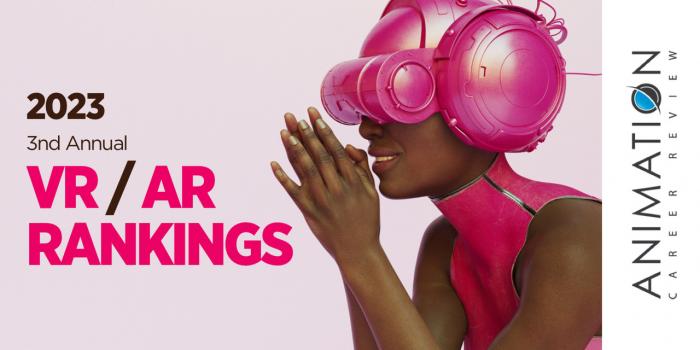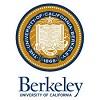
Did you know? Savannah College of Art and Design offers AR/VR resources, a green screen, a motion media lab, more than 800 computers networked to reduce render times, and immersive reality classrooms. Learn more.

| Ranking | School | State |
|---|---|---|
| 1 | University of Washington | Washington |
| 2 | Georgia Institute of Technology | Georgia |
| 3 | University of California, Berkeley | California |
| 4 | Texas A&M University | Texas |
| 5 | University of Texas at Austin | Texas |
| 6 | University of Central Florida | Florida |
| 7 | University of North Carolina at Chapel Hill | North Carolina |
| 8 | University of Michigan | Michigan |
| 9 | University of Illinois at Urbana-Champaign | Illinois |
| 10 | Arizona State University | Arizona |
| 11 | University of California, San Diego | California |
| 12 | Purdue University | Indiana |
| 13 | University of Maryland | Maryland |
| 14 | Iowa State University | Iowa |
| 15 | University of Arizona | Arizona |
| 16 | University of Utah | Utah |
| 17 | The Ohio State University | Ohio |
| 18 | University of Florida | Florida |
| 19 | University of Illinois Chicago | Illinois |
| 20 | University of Colorado, Boulder | Colorado |
| 21 | North Carolina State University | North Carolina |
| 22 | Ohio University | Ohio |
| 23 | University of California, Santa Cruz | California |
| 24 | University at Buffalo | New York |
| 25 | University of Nebraska-Lincoln | Nebraska |
Our 2023 rankings -our third annual- of the Top 25 Public College Public Augmented/Virtual Reality AR/VR programs in the US. For an explanation of ranking criteria, click here.

The College of Arts and Sciences at University of Washington (UW) houses the Paul G. Allen School of Computer Science & Engineering, which introduced the world’s first augmented reality capstone course in 2016. Serving more than 2,000 students, the school also houses several computer science programs for individuals interested in studying AR/VR. Options include the Computer Science (CS) BS, a Combined BS/MS in CS also known as the Fifth Year Master’s Program, a Professional Master’s (PMP) in CS, and CS PhD. The BS/MS enables current and recent Allen School undergraduate majors to earn both degrees in approximately five years, instead of 6.5.
Course examples across programs include Advanced Topics in HCI (Graphics & Virtual Reality), Interaction Programming, Computer Vision, Special Topics: Ubiquitous Computing, Human-Computer Interaction, Computational Fabrication, Software Engineering, Advanced Topics in Digital Animation, Applications of AI, Computational Complexity, Interactive Learning, Advanced Digital Sound Synthesis and Processing Machine Learning, and Neural Control of Movement: A Computational Perspective.
Students in all programs have the opportunity to work with an interdisciplinary team of faculty and peers in the UW Reality Lab. Launched in 2018 and housed in the Allen School, the Lab includes the Reality Studio, Reality Lab Incubator, and classes. In addition to advancing AR/VR research, Lab participants will work on projects in 3D computer vision and perception, graphics, game science and education, distributed computing, databases and computer architecture, stream processing, privacy and security, and object recognition.
Graduates of the Computer Science & Engineering Programs at University of Washington go on to establish careers at some of the world’s top companies, studios, and organizations. Examples Microsoft, Amazon, Oracle, Google, Epic Software, Adobe, Disney, HBO, Pixar Animation Studios, Dell, Apple, Riot Games, Samsung, Unity Technologies, and Hulu.
Established in 1861, University of Washington serves approximately 59,725 students across campuses in Seattle (main), Bothell, and Tacoma, Washington. UW offers more than 300 programs and 570+ degree options across in 18 colleges and schools. Engineering at University of Washington is accredited by the Accreditation Board for Engineering and Technology (ABET). University of Washington is accredited by the Northwest Commission on Colleges and Universities (NWCCU) and is a member of the Association of American Universities (AAU).

Georgia Institute of Technology (Georgia Tech) provides a number of programs for students who would like to study AR/VR. Options are housed across several colleges and schools including Ivan College of Liberal Arts; the College of Computing, which houses the Schools of Computer Science, Computational Science & Engineering, and Interactive Computing; and the School of Literature, Media, and Communication.
Specific degree programs for students interested in AR/VR include the BS in Computational Media, BS, MS and PhD degrees in Computer Science, and Minors in Computing & Devices, Computing & Intelligence, and Computing & People. The Computer Science programs provide opportunities for students to select from research areas such Virtual & Augmented Environments, Ubicomp & Wearable Computing, AI and Machine Learning, Robotics and Perception, and Geometry, Graphics, and Animation.
With approximately 300 students, the Computational Media BS is one of Georgia Tech’s fastest growing programs and a top choice for students interested in AR/VR. Students in this program have opportunities to focus in areas such as Interactive Design, Games, and Music Technology - Intelligence. Course examples include Constructing the Moving Image; Science, Technology and Performance; Video Game Design and Programming; Interaction Design; Computer Animation; and Experimental Media.
Students in all Georgia Tech programs have access to the school’s GVU Center, which supports AR/VR, AI, Robotics, HCI, Wearable Computing, and other research. Within the GVU Center is the Augmented Environments Lab, which focuses on building interactive computing environments that directly augment the users senses with computer-generated material.
Also located in the GVU Center is the Prototyping eNarrative Lab. Also known as PeN Lab, the Lab focuses on emerging platforms such as AR/VR, experimental television, and the intersection of storytelling with simulation and game design.
Examples of Lab projects include The Lights of St. Etienne: An AR/MR (Mixed-Reality) Experience in the Cathedral in Metz, France, Bringing Interactivity to Static Data Visualizations through Augmented Reality, Escape Room VR, WebXR: Experiences in AR and VR for the Web, Pipping: Exploring Passive Haptics in Virtual Reality, and Interaction Techniques for Children's AR Education, Invisible Cities: Multi-User AR Public Monuments.
Georgia Tech graduates are prepared to pursue careers in Virtual and Augmented Reality, Special Effects Creation, Interactive Game Design and Simulation, Robotics, and Animation, among others. Graduates work in leadership positions in areas such as consulting, engineering, financial services, healthcare, law, manufacturing, retail, transportation, and humanitarian logistics.
Georgia Tech alumni have been hired by companies such as Microsoft, Boeing, Apple, Disney, Tesla, Google, IBM, Delta Airlines, Intel, and Cisco Systems.
Georgia Institute of Technology was founded on October 13, 1885. When the school opened in 1888, it welcomed 129 students enrolled in one degree program—the Mechanical Engineering BS. Today, Georgia Tech serves approximately 45,300 students enrolled in more than 180 degree programs and minors across six distinct colleges and 28 schools. The school also has three campuses including the main campus in Atlanta, Georgia; Georgia Tech-Lorraine in Metz, France; and Georgia Tech-Shenzhen in China.
Georgia Institute of Technology is accredited by the Southern Association of Colleges and Schools Commission on Colleges (SACSCOC).

University of California, Berkeley (UC Berkeley) sends more graduates to Silicon Valley than just about any other college in the U.S. The schools engineering and computer science programs rank among the best in the U.S., with learning that takes place in state-of-the-art classrooms, labs, and research centers.
The Electrical Engineering & Computer Sciences (EECS) Department at UC Berkeley manages two undergraduate degrees through two different colleges: the BS in EECS in the College of Engineering (CoE), and the BA in Computer Science (CS) in the College of Letters & Science (L&S).
Both programs have the same technical requirements, with differing breadth requirements and admissions processes. Course examples for both programs include The Structure and Interpretation of Computer Programs, Designing Information Devices and Systems, Machine Structures, and Data Structures and Programming Methodology.
All EECS and CS students have access to the XR Lab@Berkeley—a Virtual, Augmented, and Mixed Reality Laboratory (AR/VR/MR), the student-run Extended Reality@Berkeley (est. 2015), and the FHL Vive Center for Enhanced Reality, which sponsors research and applications in AR/VR and AI.
Collectively, the Labs and Centers at UC Berkeley train Computer Scientists and Engineers in all areas of AR/VR. The Labs also advance the field of AR/VR through development plans, actions, and state-of-art research, while bringing attention to the unlimited possibilities associated with advancements in technology.
Graduates of the CS and EECS Programs at UC Berkeley work AR/VR, AI and Machine Learning, Software Development, Computer Systems Design, Computer Vision and Robotics, Defense, Engineering, Aerospace, Production, Design, Entertainment, and Healthcare, among others. Some of the top hiring companies for UC Berkeley graduates include Apple, Tesla, Google, and Meta.
Chartered in 1868, University of California, Berkeley was named after 18th-century philosopher George Berkeley. The school serves approximately 45,310 students enrolled in more than 350 degree programs across 15 colleges and schools and dozens of academic departments. UC Berkeley has been fully accredited since 1949 and had its accreditation reaffirmed in 2015 under the Western Association of Schools and Colleges Senior College and University Commission (WSCUC).

Texas A&M University (TAMU or Texas A&M) houses the School of Performance, Visualization and Fine Arts (TAMU PVFA), home to the Visualization Program. Ideal pathways for students interested in AR/VR include the Visualization BS, MS, and MFA degrees. The Game Design and Development Minor is also suitable.
Students in all programs have access to HCI@VIZ, which is housed in the School of Architecture’s Department of Visualization, and the MAESTRO Lab, located in College of Engineering’s Department of Aerospace Engineering. The recently launched organization—Texas A&M University Virtual and Augmented Reality (TAMUVR)—is also accessible to all students.
HCI@VIZ is lab that conducts research in Human-Computer Interaction (HCI), Human-Centered Computing, and Interactive Systems. The Lab consists of five research groups: TEILab, The StoryLab, McNamara Lab, INDIE Lab, and the Soft Interaction Lab. Depending on the group, topics explored include AR/VR, Child-Computer Interaction, Data Visualization, Embodied Interaction, Interactive Storytelling, Soft Materials Interaction, and many others. AR/VR students may be drawn to the INDIE Lab and the Soft Interaction Lab, among others.
The INDIE Lab (Interactive Data and Immersive Environments) engages in human-centered research of interactive visualizations. The group actively collaborates with multiple departments and faculty across the university. Research areas include Virtual Reality, 3D Interaction, Visual Analytics, Information Visualization, and Educational Games.
The Soft Interaction Lab fosters experimentation with physical and virtual experiences, organic materials, and interaction technology.
MAESTRO Lab houses the MAESTRO VR Studio—an Immersive Mechanics Visualization Lab dedicated Immersive and Intuitive Data Environments projects. Focus areas include AR/VR and 3D Displays.
TAMUVR is an organization that focuses on AR/VR development, research activities, educational opportunities, discussion, and practical experience.
The TEILab and McNamara Lab conduct Human-Computer Interaction (HCI) and Computer Graphics research to advance and enhance Visualization, Animation, and Computer Graphics.
Graduates of the Visualization Programs at Texas A&M University are prepared to pursue roles in AR/VR, UI/UX Development, Environment Modeling, HCI, Entertainment, and Game Asset Development, among others. TAMU alumni are routinely hired at companies and studios such as Google, Pixar, Walt Disney Animation Studios, Amazon, Industrial Light and Magic (ILM), Oracle, DreamWorks Animation, Microsoft, Electronic Arts (EA), IBM, Reel FX, Samsung, Lockheed Martin, Tektronix, General Motors, and Texas Instruments.
With more than 73,000 students, Texas A&M University the largest university in the state and one the largest in the nation. Established in 1876, TAMU is also the state’s first public institution of higher learning. The school houses 17 colleges and schools located across two campuses, the Health Science Center, and the Quatar campus. More than 400 degree programs are available. Texas A&M University is accredited by the Southern Association of Colleges and Schools Commission on Colleges (SACSCOC).

University of Texas at Austin houses the College of Liberal Arts, home to the Center for Perceptual Systems. Within the Center are state-of-the-art labs such as the Virtual Reality Laboratory and the Vision, Cognition, and Action Virtual Reality Lab. The labs focus on research in Virtual Reality Systems, Neural Mechanisms, Computation, and more.
Equipment includes HiBall high precision head tracking systems, a SensAble Technologies Phantom Force Feedback System with a large workspace, Oculus Rift DKII, several Polhemus Fastrack Systems, Motion Capture Systems, and an Immersion Cyberglove hand posture sensor with vibrotactile stimulators. An additional laboratory houses a driving simulator mounted on a motion platform, and a PhaseSpace 3D body tracking system using 40 LED Markers and 16 Impulse Cameras. The virtual environments are displayed using three Virtual Research V8 Head Mounted Displays and two N-Vis wide field of view helmets with binocular eye tracking.
The College of Natural Sciences at University of Texas Austin (UT Austin) houses the Computer Science (CS) Department, which has several pathways to study game design. The Computer Science BS (BS CS) has an optional Concentration in Game Development. Course examples for the program include Game Technology, Object-Oriented Programming, Computer Graphics, Software Engineering, and Generic Programming & STL.
For students interested in studying AR/VR, University of Texas at Austin has several program options that provide access to the Virtual Reality Labs and other related facilities.
Housed in the College of Fine Arts’ School of Design and Creative Technologies is the Department of Arts and Entertainment Technologies (AET). Within the AET Department is a Professional BS in AET with heavy AR/VR coursework. A Game Design and Development curriculum was launched in 2020 for undergraduates with career interests in the Interactive/Immersive, Gaming, and Creative industries. This program is jointly offered by the Department of Arts and Entertainment Technologies (AET), the Department of Computer Science (CS), and the Department of Radio-Television-Film (RTF).
Across programs, course examples include AR/VR: Intro to the Metaverse, Mixed Reality for the Masses, Design for Artificial Intelligence, Advanced Creative Coding, Interactive Environments, DxD Studio, Design & Interactivity, IBM Studio, User Interfaces, Integrated Design, Storytelling in Design, Immersive Audio, Video Game Prototyping, AET Studio, 3D Previz in Live Environment, and Video Game Scripting.
Note that students in Computer Science Programs in the College of Natural Science may take AR/VR courses as electives. This is especially true for the BSA in Computer Science (CS), which allows students to explore other areas to suit their goals. In addition to a BSA, CS students can earn a BS, BA, MS, or five-year BS/MS.
Graduates of the AET, Game Design, and CS Programs at UT Austin enjoy a 93% employment rate within six months of graduation. Program alumni have been hired at places such as Apple, HP, Amazon, IBM, Zynga, EA Games, Google, Scientific Games, GameStop, Diamond Entertainment, Everi Digital, Cloud Imperium, and Aspyr Media, Inc.
Founded in 1883, University of Texas at Austin serves approximately 52,385 students, making it one of the largest universities in Texas. UT Austin provides more than 155 undergraduate degree programs with 170+ fields of study, 139 graduate degree programs, and nearly 100 doctoral programs across 18 colleges and schools. University of Texas at Austin is accredited by the Southern Association of Colleges and Schools Commission on Colleges (SACSCOC).

The Department of Computer Science at University of Central Florida also houses several labs that allow students in the Certificate and Degree programs to collaborate, create AR/VR systems and applications, and conduct research related to AR/VR.
The Synthetic Reality Lab known as SREAL is part of several larger UCF entities, most notably the Institute for Simulation & Training (IST), which houses it. SREAL (pronounced Surreal) is a center for researchers, software developers, artists (modelers/animators), interactors (digital puppeteers), PhD students, and affiliated faculty members. With 7,000 square feet of experimental and office space, SREAL houses areas for the development of AR/VR, mixed reality experiences, the delivery of interactive training using digital avatar technology, human surrogate and robotics research, and developing cultural heritage and STEM experiences.
The Interactive Systems and User Experience Lab focuses on the development of innovative applications, techniques, and tools that enhance the overall experience between humans and machines.
The Computer Science BS at UCF consists of courses such as Algorithms for Machine Learning, Robot Vision, Game Programming, Software Engineering, Computer Graphics, Advanced AI, Computer Architecture, and AI for Game Programming.
Graduates of the Computer BS Program are prepared for careers in AR/VR, Computer Architecture, Computer Gaming, Computer Vision, Evolutionary Computing, Media Convergence, Robotics, and many others.
The Computer Science MS at UCF allows students to specialize in a research area. This includes options such as VR, Mixed and Virtual Reality Mobile Computing, Modeling and Simulation, Machine Learning, Human-Computer Interaction (HCI), and Artificial Intelligence (AI). Pairing (combining two research areas) is also an option. In addition to their chosen specialization, CS MS students will study programming systems and languages, computer science theory, and computer architecture.
Graduates of the Computer Science MS Program at University of Central Florida are prepared to pursue careers in AR/VR, Software Development, Computer Science, Aerospace, Computer Systems, Software Engineering, Cyber/Information Security, and Defense. UCF CS alumni are routinely hired by major companies such as NASA, Lockheed Martin, IBM, Google, Apple, Oracle, Intel, Amazon, Siemens, Cisco, YouTube, and Accenture.
University of Central Florida opened in 1968 as Florida Technological University. On the first day of classes, the school had less than 2,000 students. Today, UCF serves around 70,400 students, making it the largest university by enrollment in the state of Florida, and one of the nation’s largest universities. The school provides 240 bachelor’s degrees, 214 master’s degrees, and 81 doctorate degrees across 13 colleges. University of Central Florida is accredited by the Southern Association of Colleges and Schools Commission on Colleges (SACSCOC).

University of North Carolina at Chapel Hill (UNC-Chapel Hill) the College of Arts and Sciences, home to the Department of Computer Science (CS). Established in 1964, the CS Department was one of the first independent computer science departments in the U.S. Within the Department are several options for students who would like to study AR/VR.
Pathways include BS and MS degrees in Computer Science with a Computer Graphics or Human-Computer Interaction (HCI) Research Area. Computer Graphics sub-areas include Animation & Simulation, Virtual Environments, and Visualization. HCI offers a Virtual Environments subarea. A PhD in Computer Science is also available.
Course examples across programs include 2D Computer Graphics, Connecting Language to Vision and Robotics, Digital Culture, Digital Logic and Computer Design, Human Robot Interaction, Machine Learning, Models of Languages & Computation, Scientific Programming, and Software Engineering Laboratory.
In addition to a variety of AR/VR related courses, SCS students have access to a number of organizations and labs to support their goals. The Carolina Augmented and Virtual Reality Club (CARVR) provides the opportunity to work on extended reality (XR) projects with real clients. Students may also participate in the UNC Augmented and Virtual Reality Interest Group (UNC AR/VR), which consists of more than 250 people from across campus. The Group focuses on training, research, learning, and more through the use of immersive technologies. UNC AR/VR plans to launch two additional groups soon (a Faculty Group and Student Group), that focus on AR/VR.
Students interested in AR/VR at UNC-Chapel Hill have access to the Graphics, Imaging, and Robotics Lab and the Graphics and 3D Vision Laboratory. The Graphics, Imaging, and Robotics Lab is a 3,500 sq. ft. space located in J. Carlyle Sitterson Hall. Most of the Lab is dedicated to work in effective virtual environments. The remaining area, which houses a variety of robots, focuses on robotics research.
Housed in the Frederick P. Brooks Jr. Computer Science Building and Sitterson Hall, the new Graphics and 3D Vision Laboratory is situated in a noise-controlled, 2,500 sq. ft. space divided into three research zones by floor-to-ceiling blackout curtains for light and sound suppression. Zones include Projective Display Research, Computer Vision and Optical Tracking Research, and Physical Simulation and Audio Synthesis Research with a focus on GPU processing. The space has 11-foot ceilings and a Unistrut mounting grid.
Across facilities and labs, projects and groups have included the Effective Virtual Environments Project; Geometric Algorithms for Modeling, Motion, and Animation Group (GAMMA) Project; and the Walkthrough Group, (simulated walkthroughs of architectural models).
UNC-Chapel Hill graduates have gone on to establish careers at some of the world’s top corporations. Examples include Microsoft, Amazon, Cisco, Capital One, SAS – Analytics Software & Solutions, Red Ventures, and Accenture.
Founded in 1789, University of North Carolina at Chapel Hill welcomed its first students in 1795, becoming the first and only public university in the U.S. to award degrees in the 18th century. Today, UNC-Chapel Hill serves more than 31,500 students enrolled in over 250 bachelor’s, master’s, and PhD programs across 14 colleges and schools. University of North Carolina at Chapel Hill is accredited by the Southern Association of Colleges and Schools Commission on Colleges (SACSCOC).

University of Michigan (U-M) houses one of the world’s largest and oldest programs in Computation. Consisting of several departments and divisions and serving more than 11,000 students, the program provides access to a variety of degree and certificate options, coursework, studios, and initiatives that explore AR/VR.
Specific pathways for students interested in AR/VR are provided across the College of Engineering, the College of Literature, Science, and the Arts (LSA), and the School of Information. Options include the Computer Science BS, Computer Science and Engineering (CSE) MS, the CSE PhD, the CS Minor, and a Graduate Certificate in Extended Reality (XR).
Course examples across programs include Human-Centered Software Design & Development, Computer Game Design and Development, VLSI Design, Autonomous Robotics, Interactive Computer Graphics, Advanced Artificial Intelligence (AI), Software Engineering, Human-Computer Interaction (HCI), Digital Integrated Technology, Programming Languages, and Machine Learning.
To enhance the MS degree, graduate students may add the Graduate Certificate in XR. Open to all graduate students regardless of degree program, the XR program requires 12 credit hours of study. Students will learn about the design, construction, and evaluation of XR experiences. Course examples include AR/VR for Sustainability, Augmented Tectonics, Developing AR/VR Experiences, Educational Applications for Augmented and Virtual Reality, Immersive Media, Sci-Fi Prototyping, and Virtual Engagement in Digital Technologies.
Students in all programs have access to the XR Initiative - Center for Academic Innovation and the studios of the James and Anne Duderstadt Center (DC). Founded in 2019, the XR Initiative works across all U-M colleges, divisions, and schools to develop new XR related educational technology designed to enhance the learning experience for students. The Initiative also focuses on making XR technology more accessible on campus and encouraging its use in higher education.
Past XR Initiative projects include Cross-platform XR Tools for Supporting Student Creativity in Immersive Audio Design, Comparison of Student Learning of Head and Neck Anatomy and Diagnosis of Pathology Using XR, and XR Studio.
Launched in 1996 as the Media Union, the DC houses the Fabrication Studio, the DC Visualization Studio, M.I.D.E.N (Michigan Immersive Digital Experience Nexus), and VizHubs. All studios are equipped with state-of-the art equipment and individual workstations, advanced software, collaborative workstations, the Vicon Motion Capture System, Leap Motion System for hand tracking in VR environments, and the Perception Neuron Full Body Tracking Suit, and more.
Graduates of the Computer Science and XR Programs at University of Michigan are prepared for all roles across areas such as AR/VR, Software Engineering, Digital Arts and Entertainment, Simulation Engineering, and Applications Development.
Established in 1817 in Detroit, Michigan, University of Michigan is one of the first public universities in the nation. Consisting of three distinct, but aligned institutions in Ann Arbor, Dearborn, and Flint, Michigan, U-M serves 51,225 students enrolled in more than 275 degree programs across 19 colleges and schools. University of Michigan is accredited by the Higher Learning Commission (HLC).

University of Illinois Urbana Champaign (UIUC) houses Grainger College of Engineering, home to the Thomas M. Siebel Center for Computer Science. Within the Center is a Computer Science (CS) program that’s suitable for students interested in studying AR/VR. Specific degrees options include the BS, MS, and Minor in Computer Science (CS). The Minor consists of 12 credit hours.
Students in the CS BS have the opportunity to take up to 18 credit hours of technical electives and six hours of CS advanced electives. This allows students focus in a specific area of interest. The Media, Intelligence and Big Data, and Human and Social Impact areas include course options such as Virtual Reality, AI for Computer Games, Applied Machine Learning, Mobile Interactive Design, and Audio Computing Lab.
The CS MS is a research-oriented degree that requires 28 credit hours of coursework and a four credit hour thesis. The program consists of 10 core areas. Examples include Interactive Computing, Programming Languages, Artificial Intelligence (AI), and Scientific Computing.
Students in both the BS and MS programs have access to the VR@Illinois Lab (VR LAB). Supported by the Center for Innovation in Teaching & Learning (CITL) and University Library’s IDEA Lab and Media Commons, the VR Lab is a collaborative initiative that supports AR/VR and extended reality research, exploration, and teaching at UIUC.
The Lab houses studio spaces for VR creation and exploration, mobile virtual reality classrooms, loanable headsets and cameras for viewing and capturing 360 media, and the VR Club, which hosts weekly club meetings. Lab experts provide consultations on implementing VR in the classroom and assistance with VR research projects.
Adjacent to the VR Lab is the Innovation Studio—an active, experimental and emerging technology studio with VR headsets, a video wall, gaming computers, and a range of innovative technologies.
Graduates of the Computer Science and other related programs at University of Illinois Urbana-Champaign are routinely hired by some of the world’s top companies. Examples include Microsoft, Amazon, Google, Tesla, Meta, Apple, IBM, Caterpillar, ADM, Deloitte, Ernst & Young, and JPMorgan Chase.
University of Illinois Urbana-Champaign was established in 1867 as Illinois Industrial University. The second oldest public school in the state, UIUC serves 55,000 students from 50 U.S. states and 126 countries. More than 150 undergraduate programs and more than 100 graduate and professional programs are offered across 16 colleges and instructional units. University of Illinois Urbana-Champaign is accredited by the Higher Learning Commission (HLC).

Arizona State University (ASU) recently launched several centers and programs for students seeking careers in AR/VR. Launched in Fall 2022, the Media and Immersive eXperience (MIX) Center is a state-of-the-art facility for emerging media technologies and related academic programs. The Center houses screening rooms, immersion studios, soundstages, ideation studios, fabrication labs, community rooms, and exhibition spaces. MIX students have opportunities to design new virtual worlds and video games, create other immersive medic experiences, and produce films at the Center.
Part of the ASU at Mesa City Center Complex, which also houses The Studios at Mesa City Center and the three-acre Plaza at Mesa City Center, MIX is a collaboration between ASU and the City of Mesa.
Specific program options for students interested in AR/VR include the MS in Media Arts and Sciences (Extended Reality Technologies) and the MSD in Design (Experience Design). Both programs are administered through ASU’s Herberger Institute for Design and the Arts. The MS focus on extended reality and immersive technologies, including human-computer interaction (HCI), artificial intelligence (AI), machine learning, simulation, interaction, computer vision, experience design, and visualization.
Course examples include Designing Extended-Reality Experiences, Digital Workflow in the Graphics Industry, Movement and Computing, Creative Interactive Media, and Prototyping Futures.
The MSD is cross-disciplinary, and explores extended and virtual reality, interactive environments, games, themed entertainment, and immersive storytelling. Course examples include Prototyping Futures, Emerging Media Colloquium, and Immersive Experience Design. Both the MS and MSD require an Internship, Practicum, Applied Project, and Thesis to graduate.
Graduates are prepared careers in a wide range of industries and areas. Examples include Gaming, Software Development, Film and Video, Graphic Design, Web Development, Mobile Development, Architecture, Healthcare, Education, Advertising, 3D Modeling and Visualization, Workforce Development and Research, Urban Planning, and Experience Design.
ASU has another option for AR/VR students—the Center for Narrative and Emerging Media (NEM). Also launched in Fall 2022, NEM is a partnership between The Sidney Poitier New American Film School/Herberger Institute for Design and the Arts, and the Walter Cronkite School of Journalism and Mass Communication. Housed in the ASU California Center in Downtown Los Angeles, NEM provides an MA Program (MA-NEM) that focuses on emerging storytelling and immersive experience content creation in AR/VR/XR, virtual production, streaming, 360 video, animated graphics, and short-form digital video.
Course examples for this program include AR/VR/XR for Storytelling, Emerging Media Project Management, Emerging Media Production, Virtual Production for Storytelling, Short Form and 360 Video Production, and Narrative Development and Pre-Production. The MA-NEM Program at ASU culminates with the Applied Project, worth three credits. Graduates will leave the program with a professional portfolio of their best work.
Potential careers include AR/VR/XR Producer, Immersive Storyteller, Journalist, Documentary Film Producer, Media Project Manager, and Independent Filmmaker.
Arizona State University serves approximately 140,635 students, making it one of the largest universities in the U.S. Founded in 1885 as the Arizona Territorial Normal School, ASU has four campuses and a digital division that provide more than 900 fully accredited degree programs and majors. ASU programs are housed across 16 colleges and schools. Arizona State University is accredited by the Higher Learning Commission (HLC).

University of California, San Diego (UC San Diego) houses the CSE Virtual Reality Lab (VR Lab). Launched in 2017, the Lab is designed for students interested in developing content for virtual environments. The Lab features workshops, research opportunities in the field of AR/VR, projects, and networking opportunities. The VR Lab also houses the 300+ member VR Club at UCSD.
For students seeking a, AR/VR-related degree, UC San Diego has several degree pathways, a Minor, and Virtual Reality App Development Certificate. Provided by UCSanDiegoX, the Certificate program can be added to any degree program or taken alone. Courses include How Virtual Reality Works, Computer Graphics, and Creating Virtual Reality Apps.
Degree options are housed in Jacobs School of Engineering’s Department of Computer Science & Engineering (CSE). Pathways include the BS, MS, BS/MS, and PhD in Computer Science (CS). Required electives allow students to craft a focus, such as AR/VR. Undergraduates may choose seven electives worth four units each.
Graduate students may choose 16 units of electives and research, along with 12 units in a Depth Area such as Graphics and Vision, Human-Computer Interaction (HCI), Robotics, or AI. Programming Languages, Compilers, and Software Engineering are other options.
The MS Program also allows students to choose from three pathways: MS Plan I: Thesis; MS Plan II: Comprehensive Exam, Standard Option; and MS Plan II: Comprehensive Exam, Interdisciplinary Option. The Interdisciplinary Option provides additional opportunities to focus on a customized or available area of interest.
CSE Department focus areas include AI, HCI, Robotics, Programming Systems, Software Engineering, and Visual Computing (Computer Graphics and Computer Vision), among others.
Across programs, other features include internship opportunities, study abroad experiences, participation in the VR Club at UC San Diego and events such the Virtual Reality, Augmented Reality Hackathon sponsored by companies such as Google, Sony, HTC, and Oculus.
Graduates of the CS and Certificate Programs at University of California, San Diego are prepared to pursue positions such as AR/VR Developer, AR/VR Technician, XR Gameplay and Tools Engineer, Design/Graphics Engineer, Software Developer, AR/VR Maintenance and Support, and Graphics Engineer.
With a campus dating back to the late 1800s, University of California, San Diego was founded on November 18, 1960. The school enrolled its first undergraduates in 1964. Today, UC San Diego serves approximately 43,000 student enrolled in hundreds of programs across eight colleges. University of California San Diego is accredited by the Western Association of Schools and Colleges Senior College and University Commission (WSCUC).

Purdue University is home to Purdue Polytechnic Institute. Within the Institute is a Computer Graphics Technology (CGT) Program that allows students to customize their plan of study by selecting courses from areas such as Information Visualization, Animation, Games, and UX Design. As such, students in this flexible program have access to a range of AR/VR courses. Examples include Augmented Reality, Collaborative Virtual and Augmented Environments, Product Development Using Virtual Environments, Computer Graphics Programming, Cognition & Human-Computer Interaction (HCI), Geometric Modeling For Visualization And Communication, Game Development I-II, Visual Intelligence and Perception, Special Topics In Human-Centered Design And Development, and Advanced Real-Time Computer Graphics.
Leading to an MS in CGT (MS CGT), the program provides access to the IDEAS Research Group, which focuses on Metaverse/AR/VR, and the state-of-the-art Purdue HRD Virtual Lab. Equipment here includes Oculus Rift Virtual Reality Headsets to deliver virtual reality simulations; Microsoft HoloLens for augmented reality training simulations; GoPro Omni and GoPro Hero to create 360-degree training simulation content; and iMotions software to collect biometric data on facial expression analysis (FEA), eye tracking (ET), electrocardiography (ECG), galvanic skin responses (GSR), and facial electromyography (fEMG).
To graduate, Purdue MS CGT students will complete several projects including the Computer Graphics Project, Directed MS Capstone, and Directed MS Project. Graduates of the MS CGT Program at Purdue University are prepared to seek careers in all industries that utilize AR/VR. Graduates have been hired at places such as Google, DreamWorks, Salesforce, and Deloitte.
Established in 1869, Purdue University serves approximately 50,885 students from all 50 states and 130 countries. The school provides more than 400 programs across 11 colleges and schools. Purdue University is accredited by the Higher Learning Commission (HLC). The Art, Design, and Performance Programs at Purdue are accredited by the National Association of Schools of Art and Design (NASAD) and the National Association of Schools of Theatre (NAST).

University of Maryland (UMD) houses the College of Arts and Humanities (ARHU) and the College of Computer, Mathematical, and Natural Sciences (CMNS). ARHU serves approximately 3,070 students across 11 academic departments and three schools. Thirty-one academic majors and 37 minors are available.
The College of CMNS, which houses the Department of Computer Science (CS , is part of Brendan Iribe Center for Computer Science and Engineering. The CS Department alone serves more than 3,400 students with interests ranging from algorithms and design to VR to Robotics. Department features include research opportunities in Graphics, Visualization, and VR/AR; internships; participation in the honors program; and study abroad experiences.
Across the ARHU and CMNS Programs, students can earn a BA or BS in Immersive Media Design (IMD) or a BS, MS, BS/MS, or PhD in Computer Science with an AR/VR focus. All students learn to create, code, and collaborate using the most current digital technologies and tools. Students have the opportunity to focus in Art or Computer Science to graduate with a BA from the College of ARHU or a BS from the College of CMNS.
Students in all programs have access to the UMD Graphics and Visual Informatics Laboratory (GVIL), and the Mixed/Augmented/Virtual Reality Innovation Center (MAVRIC).
Established in 2000 by the Department of Computer Science, the GVIL explores computer graphics, scientific visualization, and virtual environments through research and education.
Current projects include applications for next-generation AR/VR, including immersive education, augmented navigation, virtual manufacturing, and medical training.
MAVRIC was created to support the future of XR, foster XR talent, and connect developers, entrepreneurs, innovators, and researchers through workshops, events, and programs.
UMD also houses the Maryland Blended Reality Center (MBRC)—a multidisciplinary partnership initially funded by the University of Maryland Strategic Partnership: MPowering the State. Launched in 2017, The Center also partners with the federal government, industry leaders, and other academic institutions to explore and develop AR/VR, MR, and other visual computing tools and applications based in immersive technologies.
Graduates of the Computer Science, IMD, and other programs at University of Maryland have established careers in the tech industry, federal laboratories, medicine, teaching, and law. Notable alumni include Naresh Gupta, Senior Vice President of Adobe’s Print and Publishing Business Unit; Brendan Iribe, Oculus Co-Founder; Sergey Brin, Co-founder of Google; and Gary Flake, a Microsoft Distinguished Engineer and founder of Yahoo! Research Labs.
University of Maryland in College Park was founded in 1856. The flagship campus of the University System of Maryland and the original land-grant institution in the state, UMD is one of only 62 members of the Association of American Universities. The school serves approximately 40,710 students enrolled in more than 300 undergraduate majors, master’s degrees, and doctoral programs across 12 colleges. University of Maryland, College Park is accredited by the Middle States Commission on Higher Education (MSCHE).

Iowa State University (Iowa State) house the Graduate College, which has several programs that are suitable for students interested in studying AR/VR. Options include MS and PhD degrees in Human-Computer Interaction (HCI), a Master of Human-Computer Interaction (MHCI) and a 12 credit hour HCI Graduate Certificate. The MS and PhD are interdisciplinary, and the MHCI is delivered entirely online.
Across programs, students will take courses such as Virtual Worlds and Applications, Visual Design for HCI, Computer Graphics and Geometric Modeling, Learn to Speak AI, Design and Evaluation of Human Computer Interaction, Python Application Development in HCI, Computational Implementation and Prototyping, Developmental Robotics, Computational Perception, Emerging Practices in Human Computer Interaction, and Foundations in Game-Based Learning.
Students in all programs have access to the Virtual Reality Applications Center (VRAC), which leads the HCI Program. This interdisciplinary research center supports the research of students and faculty from Iowa State’s seven colleges, as well as a number of industry partners and collaborators from several federal agencies.
VRAC participants have skills and interests in virtual, augmented, and mixed reality (AR/VR/MR) user experience (UX), developmental robotics, haptics interaction, HCI, and mobile computing.
Graduates of the HCI Programs at Iowa State University are prepared for careers in both the private and public sectors. Master’s degree graduates are also prepared to pursue a PhD in any related area.
Founded in 1858, Iowa State University is the nation’s first designated land-grant institution. The school serves approximately 29,970 students enrolled in more than 100 undergraduate majors and over 200 fields of study leading a graduate or professional degree. Programs at Iowa State are housed across eight colleges, two schools, and around 150 academic departments. Iowa State University is accredited by the Higher Learning Commission (HLC).

University of Arizona (UArizona) houses several labs and studios that support AR/VR research, projects, and training. Labs include the Extended Reality and Games Lab (XRG Lab) and the 3D Visualization and Imaging Systems Lab. Studios include the Terry Seligman VR Studio—UArizona’s first public virtual reality studio. Equipped with headsets and hand controllers, the VR Studio allows students, faculty, and staff to immerse in virtual spaces and environments, while working on class projects and other AR/VR-related activities.
In the XRG Lab, researchers and participants focus on the research and development of virtual, augmented, and mixed reality techniques. Ongoing research projects are funded by the National Science Foundation, the University of Arizona Social & Behavioral Sciences Research Institute (SBSRI), and others. Projects include Googly Eyes (VR), Mirrored VR, Bounce: A Mixed Reality Serious Game for Teaching Newtonian Physics Concepts, Grabbable Holograms (mixed reality) and Give Me a Hand? (virtual reality).
The 3D Visualization and Imaging Systems Lab is designed for research in emerging technologies such as mixed- and augmented realities (MR-AR), the Lab focuses on the development of 2D/3D display systems, 3D visualization systems, 3D human computer interaction methods, and image acquisition systems. Researchers are interested in applying these technologies in medicine, scientific visualization, and education.
In addition to the labs and studios and University of Arizona, faculty in the School of Information (iSchool) engage in AR/VR and other extended reality (XR) technology, video game design and development, and human-computer interaction (HCI) in order to advance these interactive technologies for enhanced performance and user experience.
Programs for students interested in AR/VR are also housed in the School of Information, which is a part of the College of Social & Behavioral Sciences. Options include the Information Science and Technology BS and a Games and Simulation Certificate. The BS Program features an Emphasis in Interactive and Immersive Technologies and hands-on learning, including internships with companies such as Hydrant, Octavia Digital Media, and the Enterprise Technology Division of State Farm Insurance.
Course examples for the program include Virtual Reality; Special Topics in Information, Science, Technology & Arts; Artificial Intelligence (AI); Information, Multimedia Design and the Moving Image; Technology of Sound; Digital 3D Modeling, Rendering and Rapid Prototyping; Human Computer Interaction; Game Development; Computing and the Arts; Ethics in a Digital World; Advanced Creative Coding; Computational Thinking and Doing; and Algorithms for Games.
The Information Science BS at University of Arizona has a required Individual Studies Component and the program culminates with the Senior Capstone course.
The Games and Simulation Certificate at UArizona explores the creation of virtual interactive environments for varying devices and platforms. Course examples for the program include Virtual Reality, Game Programming, Computing and the Arts, Technology of Sound, and Advanced Game Development. Students in this 12 credit hour Certificate Program will gain real-world experience through collaboration with peers and the development of several working prototypes.
Graduates of the iSchool at University of Arizona have been hired at places such as Lockheed Martin, Microsoft, Amazon, Intel Corporation, IBM Systems & Technology Group, Texas Instruments (TI), and Raytheon Technologies.
University of Arizona was established in 1885. The school serves approximately 49,400 students enrolled in hundreds of programs leading to a Bachelor’s, Master’s, Doctoral, or Professional Degree. Programs at UArizona are housed across 20 colleges and additional specialized schools. University of Arizona has been accredited by the Higher Learning Commission (HLC) since 1917 and is currently pursuing institutional accreditation with the Western Association of Schools and Colleges Senior College and University Commission (WSCUC).

One of the most popular Schools at University of Utah is Kahlert School of Computing (KSoC). Founded in 1965 as the Computer Science Department, the School houses research areas such as Human-Centered Computing/Virtual Reality, Robotics, Artificial Intelligence/Machine Learning, Visual Computing, High Performance Computing, and Programming Languages/Software Engineering.
Programs for students interested in AR/VR include BS and MS degrees in Computer Science. A Combined BS/MS is also available. This option allows students to complete the BS and MS in five years by taking undergraduate- and graduate-level courses in their senior year.
The BS has an Emphasis in Entertainment Arts & Engineering with multiple Focus areas including Human Centered Computing, AI/Analytics, Infrastructure, and Core Fundamentals. To complete a Focus, students must select two or more courses from any area. Course examples across areas include Virtual Reality, Machine Learning, Artificial Intelligence, Designing Human-Centered Experiences, Computer Graphics, and Mobile Application Programming.
Other course examples for the BS program include Programming Language Concepts, Interactive Machinima, Models of Computation, Traditional Game Development, Software Practice I-II, Digital Content Creation, Asset Pipeline, and Alternative Game Development.
Students in all programs have access to the Quantitative Experience Design (QED) Lab, XR Utah, and the XR Classroom.
The QED Lab is an interdisciplinary research group that explores virtual worlds, human-centered artificial intelligence (AI), experience design, and narrative & game discourse (interface) The Lab is affiliated with the School of Computing and the Entertainment Arts & Engineering Program.
XR Utah is an interdisciplinary research partnership led by the Spencer S. Eccles Health Sciences Library (EHSEB) at The U. Artists, computer scientists, educators, and psychologists across more than 16 departments at the University of Utah engage in research that helps develop new ways to learn and discover through the use virtual reality technologies.
The state-of-the art XR Classroom helps support projects that utilize projects using AR/VR. Also led by the EHSEB, the classroom and labs provide spaces where individuals can develop customized experiences involving simulations, interactive displays, and education lessons.
Graduates of the Computer Science Programs at University of Utah work in fields such as AR/VR Technology, TV and Film, Aerospace, Game Design, Engineering, Animation, HCI, Education, Architecture, Medicine, AI, and Marketing.
Founded in 1850, University of Utah is the state’s public flagship institution. A top-tier research university, The U serves approximately 34,900 students enrolled in more than 200 programs across 17 colleges and schools. University of Utah is accredited by the Northwest Commission on Colleges and Universities (NWCCU).

The College of Arts and Sciences at The Ohio State University (OSU) houses the Department of Design. Established in 1968, the Department has a Design MFA program that’s ideal for individuals interested in a career in AR/VR. This interdisciplinary program has a Digital Animation and Interactive Media (DAIM) Track. Students in this Track have the opportunity to take 12 studio elective credits in any area.
The 60 credit hour MFA Program also includes core design courses, open electives in the themes of studio/lab; history/theory/criticism; collaborative/interdisciplinary studio; writing development courses, and a thesis project. Areas covered include Real Time Graphics and Virtual Environments, Responsive and Interactive Media, Performance Animation, Game Art, and Installations.
Students in the program have access to courses such as Designing Immersive Virtual Environments, Virtual Modeling, Computer Vision for Human-Computer Interaction, Mobile Handset Systems and Networking, Programming Concepts and Applications for Artists and Designers, Integrated Tech Lab, Computer Game and Design, Survey of Artificial Intelligence I: Basic Techniques, Aspects of Art and Technology II, VCD Design Media, INT Technology, Devising Experiential Media, Motion Capture Production and Experimentation, Emerging Trends in Data Visualization, Experimental Scripting for Animation in Maya, Interactive Arts Media II: UI/UX, and Design DAIM Seminar.
Also housed in OSU’s College of Arts and Sciences is the Advanced Computing Center for the Arts and Design (ACCAD) and the Emerging Tech Studio (ETS). The ACCAD conducts research that focuses on emerging arts technologies. The Center also houses specialized and flexible studios for interactive design, animation, mediated performance design, motion capture, and media production.
The ETS provides AR/VR experiences that simulate real-world, and otherworldly scenes. VR technology and more include Meta Quest 2, Meta Quest Pro, VIVE XR Elite, and VR apps from Steam, Steam, the Oculus Rift Store, and the Oculus Quest Store.
Graduates of the Design MFA Program at The Ohio State University are prepared to pursue positions in a range of industries. Examples include Augmented Reality Designer, Mixed Reality Designer, Virtual Reality Designer, Human-Computer Interaction Designer, Visualization Specialist, Motion Graphics Designer, Game Designer, Experiential Designer, Multimedia Designer, and CG Specialist.
The Ohio State University was established in 1870 as Ohio Agricultural and Mechanical College. The school serves close to 65,795 students across six regional campuses including Columbus (main), Lima, Mansfield, Marion, Newark, and OSU’s Agricultural Technical Institute in Wooster. More than 200 majors, minors, and specializations are offered in 18 colleges and schools. The Ohio State University is accredited by the Higher Learning Commission (HLC).

University of Florida (UF) is home to the College of the Arts. Within the College is the Digital Worlds Institute, which houses the Master’s in Digital Arts & Sciences (MiDAS). This one-year, accelerated program explores emerging technologies—specifically AR/VR—and individuals from all backgrounds are encouraged to apply.
The MiDAS Program curriculum includes Technical Skills: Game Engines and Development (i.e. Unity 3D) and Software and Hardware Integration; Design and Interactivity: Visual Design Tools/Tech, 3D for AR/VR, UI-UX, Audio, Digital Compositing, and Digital Storytelling; and Professional Skills: Project Proposals, Production Pipelines, Project Management, and Critical Thinking and Analysis.
Other MiDAS Program features include opportunities to work on real-world projects in the industry; personal attention from faculty and content area experts; a collaborative environment; and professional portfolio development. UF MiDAS Students also have access to the UF Reality Lab at the Digital Worlds Institute.
The Lab explores and promotes research and educational endeavors in AR/VR. Examples of Lab courses include Production of Immersive Environments; Movement, Media, and Machines; Digital Storytelling; and Interdisciplinary Research Seminar. Past student projects include Metrolia VR Multiplayer Mech Duel; Space Mail; SpArc: Animate Using Your Hands in Virtual Reality; ScootVR; HoloTouch; and WonderLab.
Graduates of the MiDAS Program and others have been hired at Boeing, Walt Disney, GE Digital-Meridium, Cox Media Group, the U.S. Navy, Glaxo Smith Klein, the U.S. Department of Defense, Aramark, ESPN, 22squared, Reed Exhibitions, and Spirit Airlines.
University of Florida was founded in 1858 as Gainesville Academy. When it opened, the Academy has just a few students. Today, UF serves approximately 61,110 students making it one of the top 10 largest universities in the U.S. and one of the top five largest in Florida. More than 300 programs are available at UF, across 16 colleges and schools. University of Florida is accredited by the Southern Association of Colleges and Schools Commission on Colleges (SACSCOC).

University of Illinois Chicago (UIC) houses the College of Engineering. Within the College is the Department of Computer Science (CS), which is the fastest growing program at UIC. Pathways for students interested in studying AR/VR include the BS in Computer Science and Design (the only such program at a public university), a CS MS, a CS BS/MS, and a CS Minor. A CS PhD is also available for AR/VR students who would also like to pursue research or teaching positions.
Across programs, areas explored include AR/VR Design, Computer Graphics, Creative Coding, Human-Centered Computing, Designing and Developing Digital Interfaces and Applications, and Media Design. Programs consist of a combination of studio courses, electives, and required technical courses that allow students to collaborate in teams on projects and research.
Course and elective examples for the BS and Minor include Virtual, Augmented and Mixed Reality; Software Design; Artificial Intelligence; Human Augmentics; Programming Language Design and Implementation; Computer Graphics; Digital Media Design; Object-Oriented Languages and Environment; Game Design; Integrative Design Studio I-III; and Visualization.
The CS MS consists of 36 credit hours. Students may also enroll in the BS/MS Program, which takes just five years to complete. The MS has coursework only, project (capstone), and thesis options (research or PhD preparation). Course examples include Virtual Reality; Virtual, Augmented, and Mixed Reality; Advanced Machine Learning; Software Engineering; Video Game Design and Development; Applied Artificial Intelligence; Programming Language Design; Wearables and Nearables Technology Laboratory; Creative Coding; Deep Learning for computer Vision; Multimedia Systems; Human-Computer Interaction; and Design of Mobile Apps.
Students in all programs have access to UIC’s Electronic Visualization Laboratory (EVL) and the Human-in-Mind Engineering Research Lab (HiMER).
Established in 1973, EVL is an interdisciplinary research laboratory in the Department of CS. EVL specializes in virtual reality, visual data science, collaborative visualization, and advanced computing and networking infrastructure. The Lab is supported by the National Science Foundation (NSF), the National Institutes of Health (NIH), Argonne National Laboratory, The Joseph and Bessie Feinberg Foundation, the Shirley Ryan AbilityLab, the State of Illinois, and UIC.
The HiMER Lab in the College of Engineering highlights recently funded research including AR/VR, Human Performance Modeling, Human-System Interaction, Data Analytics, and Transportation Safety. Recent AR/VR projects include HiMER Lab Augmented/Virtual Reality Wearable Screen Design; Projection-Based Mixed Reality Platform-Spatial Mixed Reality; Gaze-Based Multimodal Interactions in AR; and Human Perception and Cognition in AR.
Graduates of the Computer Science Programs at University of Illinois Chicago are prepared to pursue a variety of roles in technology, entertainment, architecture, health, education, aerospace, medicine, and more. Program alumni have been hired at places such as Microsoft, Amazon, Google, Apple, Cisco, Meta, Adobe, LG, Blue Cross Blue Shield, HP, Redbox, and Verizon.
University of Illinois Chicago formed in 1982 when two University of Illinois campuses—the Medical Center campus and the Chicago Circle campus—consolidated. Today, with close to 34,000 students enrolled, UIC is the largest university in the Chicago area. The school provides 260 degree programs and more than 60 certificate programs across 14 colleges and the School of Law. University of Illinois Chicago is accredited by the Higher Learning Commission (HLC).

University of Colorado Boulder (CU Boulder) is home to the Alliance for Technology, Learning and Society (ATLAS) Institute. Founded in 1998, ATLAS houses number of labs and centers designed to support student work on independent projects. Current labs and centers include ACME Lab, Living Matter Lab, Center for Media, Arts & Performance, THING Lab, Unstable Design Lab, Laboratory for Emergent Nanomaterials, BTU Lab, and Whaaat!? Lab.
Examples of past projects include Augmented Reality and Autonomous Systems (ARIAS), Haptic VR Wizard, Augmented Reality Informs Human-Robot Interaction, Biolage Reactor, Augmented Reality Remote Assistance (ARRA), AR Drum Circle, and Jam Station.
ATLAS also manages the Creative Technology and Design (CTD) Program, with core courses taught in the Roser ATLAS Center, and degrees granted through the College of Engineering and Applied Science. Pathways for students interested in AR/VR include the BS-CTD, CTD MS, and the CTD Minor.
The BS-CTD at CU Boulder requires 128-130 credit hours of study, the CTD MS requires 33 credit hours, and the Minor requires 21 credits, including electives.
BS-CTD students may choose a focus area through elective offerings. Focus area examples include Augmented and Virtual Reality, Interactive Computing, Game Design, Robotics, Physical Computing, User Interface and User Experience (UI/UX) and Sound Design. Other program features include creative projects, regular professional development opportunities, workshops and guest speakers, internships with industry partners, employment in the CTD research and student labs, and portfolio development.
To complete the major, BS-CDT students will take a two-semester Capstone sequence, which includes the production of one major culminating project.
The CTD MS has a Creative Industries Track. The project-based curriculum for this program allows students to build their own focus area. Some popular options include Virtual and Augmented Reality, Human-Computer Interaction (HCI), Interactive Product Design and Development, Game Design and Development, Arts and Media Production, UI/UX, and Learning and Education.
Classes, visiting speakers, studios, and workshops provide the opportunity to work directly with industry professionals on real-world issues. Workshops are free and may include topics such as Programming in Python and R, Motion Graphics, Adobe Creative Suite, UI/UX, Figma, and Project Management.
Graduates of the CDT Programs at University of Colorado Boulder work in areas such as Art and Entertainment, Technology, Education, Healthcare, and Sciences. MS graduates also work in research in all industries and in many departments and agencies of the U.S. government. CU Boulder graduates have been hired by companies and studios such as Lockheed Martin, Google, Hitachi, Starz Entertainment, IBM, Walt Disney, Ball Aerospace, CBS Studio Center, Panavision, and Medtronic.
Founded in 1876, University of Colorado Boulder is the flagship university of the four-campus University of Colorado System. The school serves 36,000 students, making it the largest in the CU System. More than 90 degree programs and 3,600+ courses are provided across eight colleges and schools, Continuing Education and Professional Studies, and several Centers. University of Colorado Boulder is one of just 35 public research institutions in the U.S. in the Association of American Universities (AAU) and the school has been accredited by the Higher Learning Commission since 1913.

North Carolina State University (NC State) is home to the College of Design, which recently celebrated its 75th year in existence. Within the College are several labs including Experience Design (IX) and Mixed Reality (MxR). The IX Lab is a cross-disciplinary community of artists, designers, humanists, scientists, and engineers that focus on expanding worlds through AR/VR and other new and emerging technologies.
The MxR Lab consists of designers, engineers, and individuals interested in experimentation. The Lab focuses on AR/VR and MR technologies. Projects have included Axe One, Morphaces, and Pop’n’Play.
The College of Engineering at NC State is home to the Edward P. Fitts Department of Industrial and Systems Engineering, which houses an additional lab—the Virtual and Augmented Reality Lab (VR).
In the VR Lab researchers study the interaction between humans and AR/VR. Projects have included User Performance Training and Patient Motor Learning. Current projects include Scale Cognition through Advanced Learning Environments in Virtual Reality (SCALE-VR); Virtual Instructor Application using Augmented Reality for Worker Posture Training; and Investigation of Virtual Reality Guided Upper Limb Exercises.
Accessible equipment includes four-sided (C4) Cave Automatic Virtual Environment (CAVE) with full-body tracking capability, several head-mounted displays (HMDs), and a head-up display (HUD). In addition, a variety of peripheral devices that support movement tracking are available.
The College of Design at North Carolina State University has several programs for students interested in studying AR/VR. Options include BA and MA degrees in Art + Design (A + D) and a 16 credit hour A + D Minor with a customizable curriculum. All programs provide access to the schools AR/VR labs.
The interdisciplinary, studio-based A + D BA program provides the opportunity to learn about and develop creative portfolios in areas such as AR/VR, Interactive and Computational Media, Motion Graphics, Visual Effects (VFX), Graphic and Interactive Narratives, Game Design, 3D Modeling, and others. In addition, three Concentrations are available: Gaming + Interaction Design, Animation (2D + 3D), and Fibers + Soft Construction.
Students may also create a focus through required free electives totaling 12 credit hours. Elective examples include Advanced Digital Techniques, Digital Representation, and Art + Design Laboratory. Course examples for the program include Visualization, Art + Design Laboratory, Creative Technology, Digital Imaging, Advanced Digital Techniques, Digital Motion, and Animation. Studios include Creative technology, Art and Design International, and Design, Context, and Experience.
The A + D MA (M.A.D) focuses on Experimental Media Arts. Depending on the student’s academic background and experience, they may enroll in the 30-, 48- or 72-credit Track. Course examples include Sequential Imaging, Visualizing Narratives, Graduate Studio: Immersive and Experimental narratives, Digital Motion, Special Effects, Animation, Dynamic Data, Digital Modeling, and Coding for Designers. Final projects for the M.A.D. Program may explore AR/VR, VFX, Interactive and Computational Media, Graphic and Interactive Narratives, Visual Composition, and Motion Graphics, among others.
Graduates of the A + D programs at North Carolina State University work in fields such as Software Design, Multimedia, Illustration, Textile Design, Fashion Design, Art and Design Education, Photography, Filmmaking, SFX and VFX, Set Design, Exhibition Design, Museum Education, and Public Art. Some graduates have launched their own businesses and studios.
North Carolina State University employs 9,000+ faculty and staff that serve more than 36,000 students, making it the largest university in the University of North Carolina System. Established in 1887 as a land-grant institution focusing in agriculture and engineering, NC State offers more than 300 degree programs across 11 colleges, 68 departments, and The Graduate School. North Carolina State University is accredited by the Southern Association of Colleges and Schools Commission on Colleges (SACSCOC).

Scripps College of Communication at Ohio University houses the J. Warren McClure School of Emerging Communication Technologies (ECT), home to the Information and Telecommunication Systems BS (ITS ECT BS). Within the program is an AR/VR Track. In partnership with the School of Media Arts & Studies, McClure also has a VR and Game Development Emphasis within the Games and Animation Major.
The AR/VR Track focuses on emerging communication technologies production, including AR/VR, and information networking and telecommunication systems. Students in the program will learn about the application, management, design, management, and regulation or information network technology; the use, production, and implementation of AR/VR; and how businesses acquire and sell AR/VR products and services.
The VR and Game Development program begins with an Animation or Game Design pathway, with opportunities to enhance either area. This includes taking courses in AR/VR offered in the McClure School. The VR and Game Development Emphasis leads to a BS in Media Arts and Studies: Games and Animation.
Students in both programs at Ohio University have access to Game Research and Immersive Design (GRID) Lab. Established in 2005, the GRID Lab is an initiative of Scripps College. Developed by the School of Media Arts and Studies, the Lab focuses on the research and development of virtual reality, serious and educational games, simulations, and computer animation.
The McClure School at Ohio University has the highest job placement rate in the Scripps College of Communication. Graduates of the ITS ECT Program (AR/VR Track), have been recruited by major studios and companies such as Microsoft, Sony, Unity, Warner Brothers, Disney, and Bethesda. ITS graduates are also employed in branches of the U.S. Armed Forces, with consulting companies such as Deloitte, Accenture, Capgemini, Booz Allen Hamilton, and PwC, and with state and federal government offices.
Graduates of the Game and Animation Program with a VR and Game Development Emphasis have been hired at places such as Blizzard, Sony PlayStation, Google, Riot Games, Disney/Disney Imagineering, Electronic Arts (EA), and Unity.
Established in 1804, Ohio University is the state’s first public university. The school opened with one building, three students, and one professor. Today Ohio University’s 1,700+ faculty members serve more than 28,000 students across six campuses, and OHIO Online. Accredited by the Higher Learning Commission (HLC), Ohio University offers more than 250 academic programs housed in 11 colleges, 16 schools, and dozens of departments.

University of California, Santa Cruz (UC Santa Cruz or UCSC) has a number of paths to study AR/VR. The Baskin School of Engineering at UCSC houses the Computational Media Department (CM), which has BS and MS Programs in Computer Science (CS), as well as Computational Media MS and PhD programs. Students in all pathways may focus in AR/VR by selecting related courses and electives.
Examples include Introduction to Augmented Reality and Virtual Reality, Data Visualization with AR/VR, Programming Abstractions: Python, Advanced Computer Graphics and Animation Laboratory, Artificial Intelligence (AI), Immersive Analytics, Human-Computer Interaction Seminar, C Programming, Topics in Human-Robot Interaction, AI in Games, Software Engineering, Interactive Narrative, Computer Systems, Data Programming for Visualization, User Experience for Interactive Media, and Machine Learning for Creativity and Design.
Across all programs, students will complete a variety of projects, both assigned and in their area of choice. Graduate students will complete a thesis OR additional project with written report.
All Baskin students have the opportunity to work and learn in the VizLab. Dedicated to AR/VR, VizLab provides access to high-end VR equipment that can be used to develop virtual or augmented reality content and interact with imagined worlds. Students can check out equipment such as a VIVE headset, Gear VR, Google Cardboard, 360 cameras, GoPros, DSLR cameras, video cameras, and other media capture devices. The VizLab also hosts class sessions, workshops, and project development meetings.
Another space—the Cave Automatic Virtual Environment (CAVE) Lab—provides the opportunity to create 3D virtual environments that allow multiple users to interact at the same time. The facility houses a room-sized, advanced visualization system (also called the CAVE), which combines high-resolution, stereoscopic projection and 3D computer graphics to create and fully immerse in virtual environments.
The CAVE Lab is also outfitted with Mechdyne CAVE and FLEX technology and adjustable walls that allow environments to be modified for different applications. The Unity development platform is used to create 3D interactive environments.
For students in other programs across UC Santa Cruz or professionals looking to develop skills in AR/VR skills may enroll in a Certificate Program through UCSC Silicon Valley Extension. Options include Software Engineering and Quality, User Experience and Web Design, and Mobile Application Development. Across options, students have access to courses such as Designing User Experience for AR, Smart Things, Virtual Reality, and Wearable Technology; Mobile Interface Design; and Data Structures and Algorithms Using Python.
Other features include hands-on projects, guest speakers, and topics such as Software Engineering, Augmented Reality - UX Design, Virtual Reality - UX/UI Design (Oculus Rift and Samsung Gear VR), Artificial intelligence (AI), Designing Glasses for AR, Visual Design, Design Implementation, and Interface Design. Certificate students will have a professional portfolio upon completion of their respective programs.
Graduates of the Computer Science Programs and Certificate Programs at University of California, Santa Cruz are prepared for positions such as AR/VR Developer, XR Gameplay and Tools Engineer, Software Developer, AR/VR Maintenance and Support, Senior Software Engineer, AR/VR Capture Systems Engineer, Design/Graphics Engineer, and AR/VR Researcher.
Established in 1965, University of California, Santa Cruz opened with 652 students. Today, the school serves approximately 18,980 students enrolled in more than 130 programs in the Arts, Engineering, Humanities, Physical and Biological Sciences, and Social Sciences. Programs at UC Santa Cruz are housed across 10 colleges and the Graduate Division. University of California, Santa Cruz is accredited by the Western Association of Schools and Colleges (WASC) Senior College and University Commission (WSCUC).

University at Buffalo (UB) is home to the College of Arts and Sciences, which houses the Department of Media Study (DMS) and the Department of Computer Science and Engineering. Both Departments provide several paths to study AR/VR.
DMS options explore games, AR/VR, robotics, experimental film, interactive, fiction, and other areas. Research areas for DMS faculty include Games and Virtual Reality, Emerging Media, Music and Sound, and Film and Video, among others. Games and Virtual Reality researchers study and build virtual worlds, mixed reality experiences, responsive installations, intermedia performances, and games.
Undergraduate DMS programs for students interested in AR/VR include the Media Study BA with a Concentration in Production, and the Game Studies Certificate. Graduate options include the MFA in Media Arts Production MFA (interactive media, computational media, physical computing); the Media Arts and Architecture Program (MAAP) with a Master of Fine Arts (MFA) + Master of Science in Architecture (MS) Track for students with a prior degree in the arts, design, humanities, computer science and engineering or related fields; and the Media Study PhD (including interactive media, physical computing, production, and digital media).
Most coursework across programs have AR/VR and related components. Examples include Virtual Worlds I-II, Emerging Technologies, Media Robotics, Programming Graphics I-II, Game Design, Interactive Fiction, Computational Media, Sound and Space, Physical Computing, Programming for Digital Art, Green Media, Electronic Literature, Sound Design, Video Workshop, Game Design, Machines, Codes, and Cultures, Game and Animation Workshop, Time-Based Concepts, Performative Action, and Designed Play.
Other DMS features include small class sizes (15-18 students), team projects, internship opportunities, and an active study abroad program.
The Department of Computer Science and Engineering at UB is part of the School of Engineering and Applied Sciences. Program options for students who would like to study AR/VR include the Computer Science BA, Computer Science BS/MBA, Computer Science BS/Computer Science and Engineering MS, the Computer Engineering MS, and the Mechanical Engineering BS. All programs provide access to the UB Virtual Reality Lab, housed in the School of Engineering and Applied Sciences’ Department of Mechanical and Aerospace Engineering.
Course examples across programs include Applied Human-Computer Interaction (HCI) and Interface Design, Introduction to Artificial Intelligence (AI), Programming in Python, Machine Learning and Society, Coding Theory, Software Engineering, Computer Vision and Image Processing, Robotic Algorithms, Digital Image Processing, Computer Programming I-II, Systems Programming, Digital Systems, and The Learning Environment.
Graduates of the Computer Science and DMA Programs are prepared to pursue careers in all industries that utilize AR/VR. University at Buffalo graduates are routinely recruited by some of world’s top companies. Examples include Lockheed Martin, IBM, Thermo Fisher Scientific Inc., Eli Lilly, Google, Fisher-Price, Amazon, and Carleton Technologies.
Founded in 1846, University at Buffalo is the flagship institution of the State University of New York (SUNY) System. The school serves approximately 32,100 students, making it the largest campus in the 64-campus SUNY System. With more than 1,000 study abroad opportunities across seven continents, UB also has one of the largest overseas education programs in the U.S. University at Buffalo provides more than 500 programs across 13 colleges and schools. UB is accredited by the Middle States Commission on Higher Education (MSCHE), and it is a member of the Association of American Universities.

University of Nebraska-Lincoln (UNL) is home to the Hixson-Lied College of Fine and Performing Arts. Within the Hixson-Lied College is the Johnny Carson Center for Emerging Media Arts, which has one pathway to study AR/VR. The program—Emerging Media Arts BFA (BFA-EMA)—requires two emphasis areas totaling 24 credit hours; an interdisciplinary concentration; and 27 credit hours of electives. This provides a number of opportunities to study AR/VR.
Popular emphasis options for AR/VR students include Immersive and Interactive Media (games, VR, AR, XR, interactive and immersive environments); Experience Design (designing projects and experiences that synthesize the virtual and the real); Virtual Production (animation, motion graphics, 3D modeling); Sensory Media (physical computing, wearable technologies, human computer interaction-HCI, hardware and software); and Data + Art (generating art with artificial intelligence-AI, data, and the Internet of Things).
In addition to completing courses such as Creating Augmented Worlds, Principles of Interactivity, Creating Virtual Worlds, Experience Design, and Game Engines for Real-Time Performances, BFA-EMA students will also spend two semesters each in a total of five studio and lab courses including Innovation Studio, Sound Lab, Computation and Media Studio, Visual Expression Studio, and Story Lab. Other program features include the Entrepreneurship course and a yearlong Capstone Project.
Housed in the College of Business, the Entrepreneurship course introduces students to the fundamentals of entrepreneurship and business creation. The Capstone Project allows students to work in teams to from concept and development to prototype and finished product. Completed projects will be ready for distribution.
Graduates of the Emerging Media Arts BFA Program at University of Nebraska-Lincoln have been hired for positions in areas such as Wearables and Physical Computing, AI, Robotics, Sound Design, Game Design, Visual Effects (VFX), Film Production Design, and Animation. Potential job titles include AR/VR Designer, Theme Park Experience Designer, Game Designer, Creative Technologist, AR/VR Developer, Interactive Designer, Innovation Designer, App and Designer, Mobile Media Designer, Technology Interactives Researcher and Developer, UX Design Lead, and Video Game Director.
Founded in 1869 and serving 23,805 students, University of Nebraska – Lincoln is the state's oldest university and the largest institution in the University of Nebraska System. UNL provides more than 70 doctoral programs and over 150 majors, 70+ master's degree programs, and more than 30 graduate certificates. Programs at UNL are housed across nine colleges. University of Nebraska-Lincoln is accredited by the Higher Learning Commission (HLC).